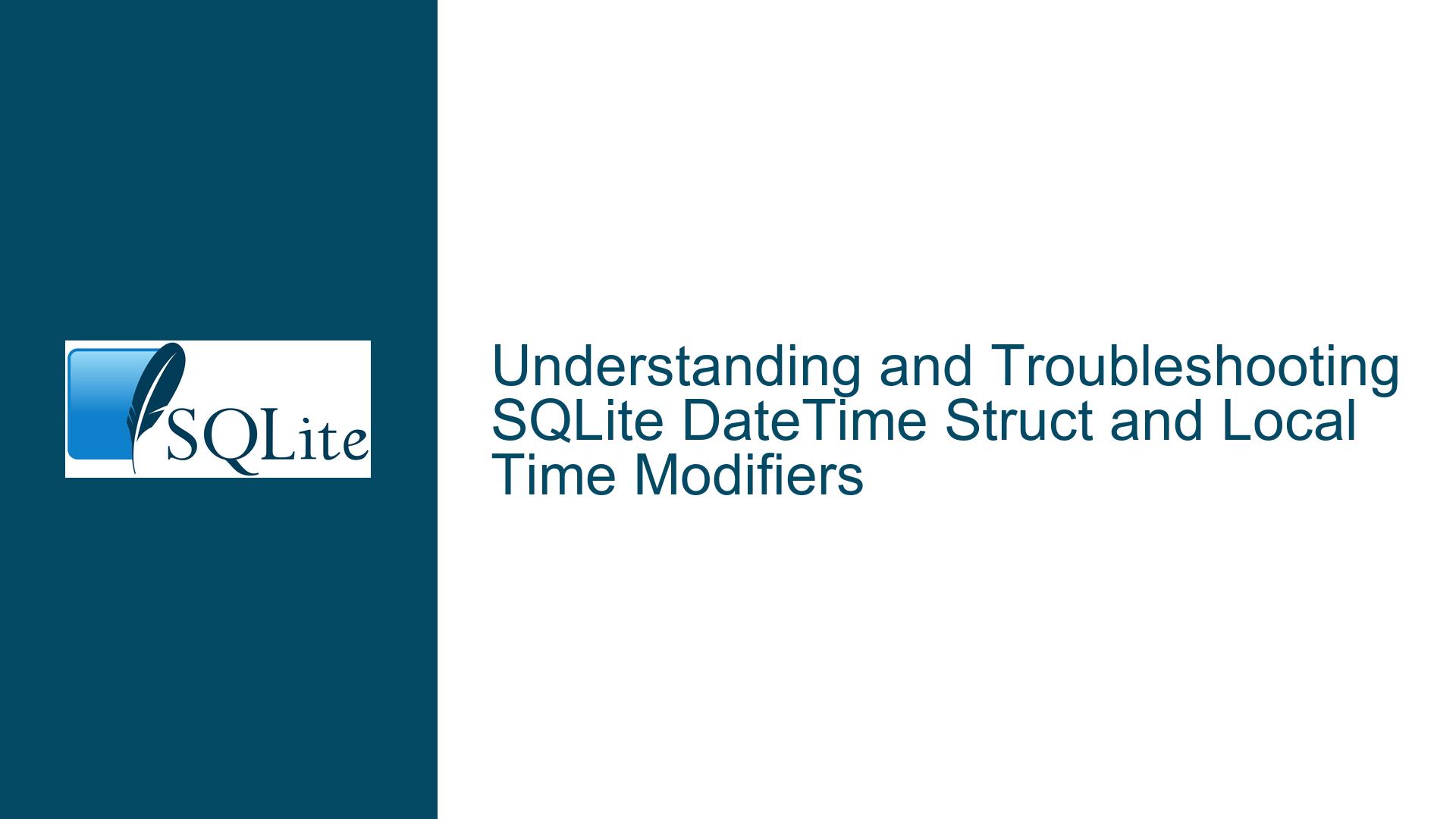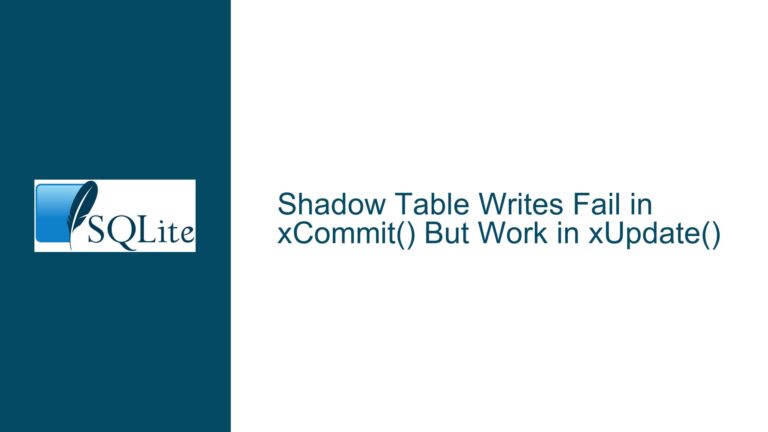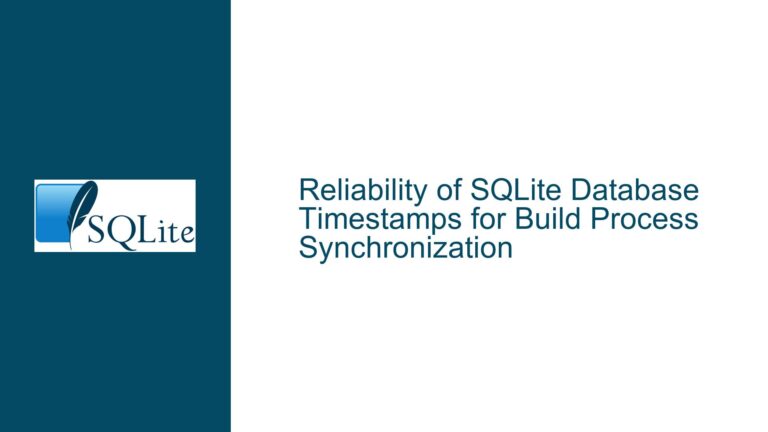and Troubleshooting SQLite DateTime Struct and Local Time Modifiers
Issue Overview: DateTime Struct Behavior with Local Time Modifiers
The core issue revolves around the behavior of the struct DateTime in SQLite’s src/date.c file, particularly when interacting with the localtime modifier. The struct DateTime is a critical component of SQLite’s date and time handling, and its fields (iJD, tz, h, m, D, M, Y, and isLocal) are used to represent and manipulate date and time values. The problem arises when the localtime modifier is applied to a date/time value, as it does not behave as expected in relation to the iJD and tz fields.
The iJD field represents the Julian Day number, which is a continuous count of days since the beginning of the Julian Period (January 1, 4713 BCE in the Julian calendar). The tz field represents the timezone offset, which is used to adjust the iJD value to reflect local time. When the localtime modifier is applied, the expectation is that the tz field would be adjusted to reflect the local timezone offset, while the iJD field would remain unchanged, representing the same moment in time globally. However, the observed behavior is that the localtime modifier directly modifies the iJD field, as well as other fields such as h, m, D, M, and Y, while the isLocal field remains unchanged at 0.
This behavior is counterintuitive because the iJD field, like a UNIX timestamp, should represent the same moment in time globally, with local time differences being expressed through the tz field. The fact that the localtime modifier directly modifies the iJD field suggests that there may be an issue with how the struct DateTime fields are being handled when the localtime modifier is applied.
Possible Causes: Misalignment Between iJD and tz Fields in DateTime Struct
The misalignment between the iJD and tz fields in the struct DateTime when the localtime modifier is applied can be attributed to several potential causes. These causes stem from the design and implementation of the struct DateTime and the localtime modifier in SQLite’s src/date.c file.
Incorrect Application of the Local Time Modifier: The
localtimemodifier may be incorrectly applied to theiJDfield instead of thetzfield. This would result in theiJDfield being adjusted to reflect local time, rather than thetzfield. This could be due to a misunderstanding of how theiJDandtzfields are intended to interact, or it could be a bug in the implementation of thelocaltimemodifier.Misinterpretation of the
isLocalField: TheisLocalfield is intended to indicate whether the date/time value is in local time or UTC. However, the fact that theisLocalfield remains 0 when thelocaltimemodifier is applied suggests that this field may not be functioning as intended. This could be due to a bug in the implementation of thelocaltimemodifier, or it could be due to a misunderstanding of how theisLocalfield is intended to be used.Inconsistent Handling of Date/Time Fields: The
localtimemodifier appears to be directly modifying not only theiJDfield but also other fields such ash,m,D,M, andY. This suggests that there may be an inconsistency in how thestruct DateTimefields are being handled when thelocaltimemodifier is applied. This could be due to a lack of clear documentation or guidelines on how thestruct DateTimefields should be handled in different scenarios.Lack of Documentation on
struct DateTimeFields: Thestruct DateTimefields are not well-documented, and thesrc/date.csource code may be the only available documentation. This lack of documentation could lead to misunderstandings or misinterpretations of how the fields are intended to be used, particularly in relation to thelocaltimemodifier.Potential Quirks in Julian Day Calculation: The Julian Day (JD) is defined as the number of days since the beginning of the Julian Period, and it represents the same moment in time globally. However, there may be quirks or edge cases in the calculation of the Julian Day that could affect how the
iJDfield is handled when thelocaltimemodifier is applied. These quirks could be related to differences in Earth’s rotation speed or other factors that are not immediately obvious.
Troubleshooting Steps, Solutions & Fixes: Addressing DateTime Struct and Local Time Modifier Issues
To address the issues with the struct DateTime and the localtime modifier, the following troubleshooting steps, solutions, and fixes can be implemented:
Review and Clarify the Purpose of
struct DateTimeFields: The first step is to review and clarify the purpose of each field in thestruct DateTime. This includes understanding how theiJDandtzfields are intended to interact, as well as the role of theisLocalfield. This can be done by examining thesrc/date.csource code and any available documentation, and by consulting with other developers who have experience with SQLite’s date and time handling.Correct the Application of the Local Time Modifier: If the
localtimemodifier is being incorrectly applied to theiJDfield instead of thetzfield, this should be corrected. Thelocaltimemodifier should adjust thetzfield to reflect the local timezone offset, while leaving theiJDfield unchanged. This will ensure that theiJDfield represents the same moment in time globally, with local time differences being expressed through thetzfield.Fix the
isLocalField Behavior: TheisLocalfield should be set to 1 when thelocaltimemodifier is applied, indicating that the date/time value is in local time. If theisLocalfield remains 0 when thelocaltimemodifier is applied, this should be corrected. This will ensure that theisLocalfield accurately reflects whether the date/time value is in local time or UTC.Ensure Consistent Handling of Date/Time Fields: The
localtimemodifier should consistently handle all fields in thestruct DateTime. If thelocaltimemodifier is directly modifying fields such ash,m,D,M, andY, this should be reviewed and corrected if necessary. Thelocaltimemodifier should primarily adjust thetzfield, with other fields being adjusted as needed to reflect the local time.Document the
struct DateTimeFields: To prevent future misunderstandings or misinterpretations, thestruct DateTimefields should be thoroughly documented. This documentation should include a clear explanation of the purpose of each field, how they interact with each other, and how they should be handled in different scenarios, such as when thelocaltimemodifier is applied.Test for Edge Cases and Quirks in Julian Day Calculation: The calculation of the Julian Day should be tested for edge cases and quirks that could affect how the
iJDfield is handled when thelocaltimemodifier is applied. This includes testing for differences in Earth’s rotation speed and other factors that could affect the accuracy of the Julian Day calculation.Implement Unit Tests for Local Time Modifier: Unit tests should be implemented to ensure that the
localtimemodifier behaves as expected in all scenarios. These tests should cover a wide range of date/time values, timezones, and edge cases to ensure that thelocaltimemodifier correctly adjusts thetzfield and other fields as needed.Consult with the SQLite Community: If the issues with the
struct DateTimeand thelocaltimemodifier cannot be resolved through internal review and testing, it may be helpful to consult with the broader SQLite community. This could involve posting a detailed description of the issue on the SQLite forum, along with any relevant code snippets and test cases, to solicit feedback and suggestions from other developers.
By following these troubleshooting steps, solutions, and fixes, the issues with the struct DateTime and the localtime modifier can be addressed, ensuring that SQLite’s date and time handling functions as intended in all scenarios.






